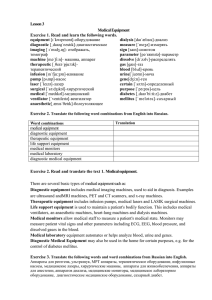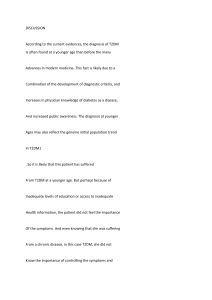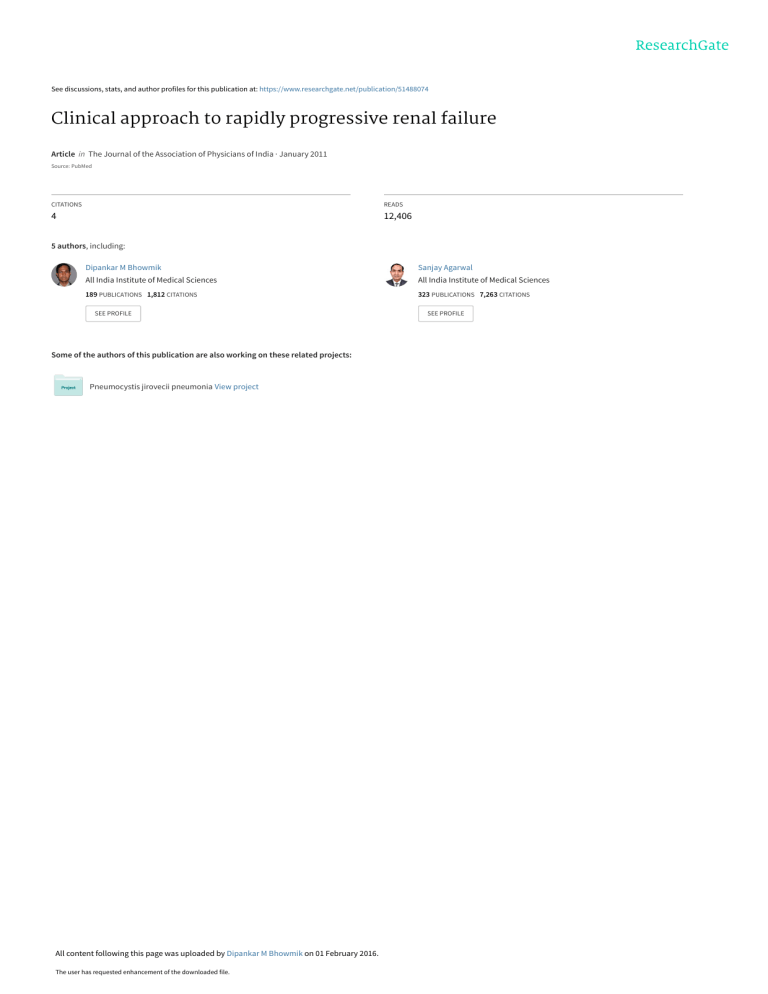
See discussions, stats, and author profiles for this publication at: https://www.researchgate.net/publication/51488074 Clinical approach to rapidly progressive renal failure Article in The Journal of the Association of Physicians of India · January 2011 Source: PubMed CITATIONS READS 4 12,406 5 authors, including: Dipankar M Bhowmik Sanjay Agarwal All India Institute of Medical Sciences All India Institute of Medical Sciences 189 PUBLICATIONS 1,812 CITATIONS 323 PUBLICATIONS 7,263 CITATIONS SEE PROFILE Some of the authors of this publication are also working on these related projects: Pneumocystis jirovecii pneumonia View project All content following this page was uploaded by Dipankar M Bhowmik on 01 February 2016. The user has requested enhancement of the downloaded file. SEE PROFILE Review Article Clinical Approach to Rapidly Progressive Renal Failure Dipankar Bhowmik*, Sanjeev Sinha+, Ankur Gupta**, Suresh C Tiwari++, Sanjay K Agarwal*** Abstract Rapidly progressive renal failure (RPRF) is an initial clinical diagnosis in patients who present with progressive renal impairment of short duration. The underlying etiology may be a primary renal disease or a systemic disorder. Important differential diagnoses include vasculitis (systemic or renal-limited), systemic lupus erythematosus, multiple myeloma, thrombotic microangiopathy and acute interstitial nephritis. Good history taking, clinical examination and relevant investigations including serology and ultimately kidney biopsy are helpful in clinching the diagnosis. Early definitive diagnosis of RPRF is essential to reverse the otherwise relentless progression to end-stage kidney disease. Concept of Rapidly Progressive Renal Failure I n clinical medicine physicians encounter patients who present with progressive renal impairment of seemingly unknown etiology. The duration of disease is brief or may even be undefined. These patients are neither Acute Kidney Injury (previously called acute renal failure) nor Chronic Kidney Disease (previously called chronic renal failure). The initial clinical diagnosis of these cases may be called Rapidly Progressive Renal Failure (RPRF), which may be defined as progressive renal impairment over a period of few weeks. On ultrasonography of the kidneys, patients with RPRF have normal sized kidneys, while the presence of small contracted echogenic kidneys establishes the diagnosis of CKD. Actually RPRF encompasses a heterogeneous group of clinical syndromes.1 The renal histopathology shows lesions affecting any or a combination of the three traditional renal compartments: glomerular, tubulointerstitial or vascular. The diseases causing RPRF are listed in Table 1. Since a wide variety of different diseases may present with a similar clinical picture, it is essential to properly work-up cases of RPRF so that the exact diagnosis is established. Time is a valuable factor since if the appropriate treatment is not initiated, then the patient may progress to irreversible end-stage renal disease (ESRD) needing life-long renal replacement therapy. RPRF may in fact be considered as ‘Renal Emergency’. Hence the role of the physician, who sees the patients in the initial stages is vital to ensure optimal management of RPRF. The traditional approach to a patient namely history, physical examination and appropriate investigations all play a vital role in the diagnostic work-up. Ultimately kidney biopsy is required in most patients. History Detailed and appropriate history taking is essential both to make the initial diagnosis of RPRF (by excluding CKD and AKI), and also to arrive at the cause of RPRF. History of hematuria, hemoptysis, longstanding asthma or petechiae is suggestive of vasculitis, while arthralgia, oral ulcers or photosensitivity indicates presence of lupus. In the middle aged and elderly it Associate Professor, ** Senior Resident, ***Professor and Head, Department of Nephrology, +Associate Professor, Department of Medicine, All India Institute of Medical Sciences, New Delhi, ++Head of Department of Nephrology, Fortis Hospital, New Delhi. Received: 03.02.2010; Revised: 05.03.2010; Accepted: 05.03.2010 * 38 is essential to ask for history of backache or bone pains, since multiple myeloma sometimes presents with renal impairment. While evaluating a case of suspected RPRF, it is essential to diligently go through the medical records of the patient.2 It is not unusual to find documentation of abnormal urine examination and / or impaired renal function of which the patient is unaware of. Long-standing history of diabetes and hypertension makes it likely that the patient has diabetic or hypertensive nephropathy. Physical Examination Since anemia is one of the important features of CKD, absence of pallor is one of the signs that may suggest RPRF. In general, patients with RPRF have normal BP. However hypertension is a feature in patients with underlying thrombotic microangiopathy (TMA) and renal artery stenosis. Finding of oral ulcer or butterfly rash is indicative of lupus, while skin petechiae may indicate lupus or vasculitis. Investigations The sine qua non of RPRF is impaired renal functions in a patient with short history (2 weeks – 3 months). The most important investigation which suggests the diagnosis of RPRF is the presence of normal sized kidneys on ultrasonographic examination of the abdomen. Significant dilatation of the pelvicalyceal system and the ureters suggests obstruction to the urinary tracts. Urine examination by a trained pathologist is of great help. Active urinary sediment (proteinuria, dysmorphic RBCs and RBC casts) suggests proliferative glomerulonephritis, while hematuria with isomorphic RBCs is indicative of acute interstitial nephritis. Table 2 gives a list of non-invasive investigations which are useful to arrive at the cause of RPRF. Appropriate investigations need to be sent depending on the history and clinical findings. Role of Kidney Biopsy As mentioned earlier, most cases of RPRF need a renal biopsy either to make the correct diagnosis or to understand the chronicity of the disease process. The various histological diagnoses, which may be seen in patients with RPRF are as follows: Crescentic Glomerulonephritis One of the most important causes of RPRF is Rapidly Progressive Glomerulonephritis (RPGN). RPGN is a clinic© JAPI • january 2011 • VOL. 59 Table 1: Diagnostic Causes of Rapidly Progressive Renal Failure 1. Primary Renal Diseases a. Glomerular diseases i. Renal limited Vasculitis: Microscopic polyangiitis, ANCA neg. pauci-immune GN, Goodpasture’s disease ii. Post-infective crescentic glomerulonephritis iii. Idiopathic Collapsing glomerulopathy iv. IgA nephropathy, Membrano-proliferative glomerulonephritis v. Fibrillary glomerulonephritis b. Tubulo-interstitial diseases i. Acute interstitial nephritis ii. Acute tubular necrosis c. Vascular diseases i. Atheromatous and thrombo-embolic renovascular disease ii. Bilateral renal vein thrombosis 2. Systemic diseases affecting the kidney a. Systemic vasculitis i. Wegener’s granulomatosis ii. Churg-Strauss Syndrome iii. Goodpasture’s syndrome iv. Henoch-Schonlein Purpura v. Cryoglobulinemia vi. Drugs- hydrallazine, allopurinol, rifampicin, propylthiouracil, carbimazole vii. Rheumatoid vasculitis, paraneoplastic vasculitis b. Multiple myeloma c. Systemic Lupus Erythematosus i. Class IV lupus nephritis ii. Antiphospholipid antibody syndrome d. Thrombotic microangiopathy i. HUS / TTP ii. Malignant hypertension iii. Systemic sclerosis e. Infections i. Infective endocarditis ii. Occult viscera sepsis iii. Hepatitis C f. Sarcoidosis g. Obstructive nephropathy i. Retroperitoneal fibrosis ii. Pelvic malignancy eg carcinoma cervix pathological syndrome; and is characterised clinically by rapid loss of renal function, and pathologically by extensive crescents often with necrosis of the glomerular tuft.3 A crescent forms as a result of the proliferation of the glomerular epithelial cells resulting in compression of the glomerular tuft (Figure 1). Crescentic glomerulonephritis occurs commonly in the various forms of vasculitis (both primary renal and systemic); and occasionally in post-infective glomerulonephritis, lupus nephritis, IgA nephropathy and membrano-proliferative glomerulonephritis.4,5 Clinical features of RPGN may consist of cola-coloured urine, generalized non-specific constitutional symptoms or a flu-like syndrome. Blood pressure is normal or only slightly raised. Purpura may be present. Signs and symptoms of the underlying disease may be present, and provide © JAPI • january 2011 • VOL. 59 Table 2 : Investigations which give a clue to the diagnosis of RPRF Investigation Leucocytosis Diagnosis Sepsis, Vasculitis, Thromboembolic disease Eosinophilia Churg-Strauss Syndrome, AIN Thrombocytopenia HUS / TTP Peripheral smear with fragmented TMA RBCs Urine dipstick protein negative to Multiple myeloma 1+ only, but 24 hr collection: total proteins disproportionately high Urine showing active sediments Vasculitis, Lupus nephritis, Dysmorphic RBCs RBC casts Proteinuria (sub-nephrotic) Urine with isomorphic RBCs AIN Eosinophiluria AIN, Thrombo-embolic disease Urine showing nephrotic range Collapsing / Fibrillary proteinuria Glomerulonephritis Serum: Hypercalcemia Sarcoidosis Serum: Hypercalcemia, Multiple myeloma hyperuricemia, raised globulins Serum LDH raised TMA, Thrombo-embolic disease Serological tests positive for: ANA Lupus Nephritis C3, C4 and CH50 reduced Lupus nephritis, Cryoglobulinemia C3 and CH50 reduced, C4 normal Post-streptococcal glomerulonephritis Antiphospholipid antibodies Antiphospholipid antibody against antigens: anticardiolipin, syndrome anti-b2glycoprotein ANCA Vasculitis (Pauci-immune glomerulonephritis) Anti-GBM antibodies Goodpasture’s Syndrome / Disease Anti-Streptolysin O (ASLO) Post Streptococcal Anti-DNAase Glomerulonephritis Rheumatoid factor Rheumatoid vasculitis Anti-Scl 70 Systemic sclerosis Cryoglobulins Cryoglobulinemia Anti Hepatitis C antibodies MPGN HIV antibodies Collapsing Glomerulopathy, TMA HBsAg MPGN, vasculitis ADAMTS 13 deficiency TTP Serum protein electrophoresis Multiple myeloma showing ‘M’ spike Urine protein electrophoresis for k & l chains X-ray Chest showing cavities Wegener’s Syndrome USG kidneys: Normal size RPRF /AKI Small size Chronic kidney disease CT scan abdomen Retroperitoneal fibrosis Bone marrow examination Multiple myeloma Doppler/ CT Angio / MR Renal artery stenosis Angiography a clue to the diagnosis. A small but significant percentage of patients may be asymptomatic. The two important tests, which help in the differential diagnosis of RPGN are serum Antineutrophilic Cytoplasmic antibody (ANCA), which is of two types viz. p-ANCA (directed against myeloperoxidase) and 39 Fig. 3 : Kidney biopsy (H & E x400) showing occluded arteriole Fig. 1 : Silver stain (x 400) showing a glomerulus with a circumferential cellular crescent compressing the glomerular tuft Kidney Biopsy Crescentic glomerulonephritis 2. Negative Kidney Biopsy IF negative pauci-immune Microscopic polyangiitis Wegener’s Granulomatosis Churg-Strauss Syndrome Kidney Biopsy IF positive Linear deposition Anti-GBM disease Granular deposition Low C3 Systemic Lupus Erythematosus Cryoglobulinemia Post-infectious GN Normal C3HSP IgA nephropathy HSP IF: Immunofluorescence Fig. 2 : Algorithm for Differential diagnosis of Rapidly progressive glomerulonephritis c-ANCA (directed against PR3); and the immunofluorescence (IF) examination of the kidney biopsy. Figure 2 depicts an algorithm using ANCA and IF in patients with crescentic glomerulonephritis to arrive at the exact diagnosis.6,7 A large majority of cases of crescentic glomerulonephritis are pauciimmune.3 Anti-GBM disease is quite rare and accounts for about 5% of all cases of crescentic glomerulonephritis.7 Lupus Nephritis Occasionally lupus presents initially only with renal involvement. Lupus nephritis is diagnosed on kidney biopsy along with evidence of positive serology. Immunofluorescence examination showing deposition of IgG, IgM, IgA, C3 and fibrinogen (full-hose deposition) is highly suggestive of lupus nephritis. The classification of lupus nephritis into 5 classes is based primarily on the glomerular involvement.8 However lupus nephritis also involves the interstitium and renal blood vessels in varying degrees.9 RPRF occurs mainly in two groups of patients: 40 b. Necrotising crescentic glomerulonephritis Thrombotic microangiopathy as a result of lupus nephritis These entities can only be diagnosed by kidney biopsy. Hence it is desirable to perform kidney biopsy in all lupus patients with active urinary sediments, so that these entities can be diagnosed early. Appropriate immunosuppression can help in achieving renal recovery. Delay in diagnosis results in irreversible loss of renal function. Thrombotic Microangiopathy Anti-GBM antibody positive 1. Diffuse endocapillary proliferative glomerulonephritis (DPGN) This is associated with the presence of antiphospholipid antibodies Serum Anti-Neutrophil Cytoplasmic Antibody Positive a. Lupus nephritis Class IV Thrombotic microangiopathy affects arterioles and glomerular capillaries. The histologic lesions of arteriolar type of TMA consist of myointimal proliferation, reduplication of the lamina elastica and intraluminal platelet thrombi resulting in partial or total obstruction of the vessel lumen (Figure 3). The glomeruli, when affected, show thrombi in the capillary loops and mesangiolysis. The important causes of TMA include Shiga-toxin induced HUS, TTP due to ADAMTS13 deficiency, pregnancy, antiphospholipid antibody syndrome, systemic sclerosis, malignant hypertension and certain drugs.10 TMA is suspected on the basis of history, thrombocytopenia and evidence of microangiopathic hemolytic anemia (peripheral smear showing fragmented RBCs and raised serum LDH). Multiple Myeloma Occasionally multiple myeloma presents to the clinician primarily as RPRF without the classical symptoms. Hence a high index of suspicion is needed especially if investigations reveal hypercalcemia in the presence of renal impairment, hyperuricemia and raised serum globulins. The diagnosis is made by serum and urine protein electrophoresis, and bone marrow examination Early diagnosis and institution of treatment may reverse the renal failure. Thrombo-embolic Disease Atheromatous renal artery stenosis and cholesterol embolisation to the kidney are often associated, and are a cause of ischemic renal disease leading to subacute renal failure. © JAPI • january 2011 • VOL. 59 Thrombo-embolic renal disease occurs as a result of cholesterol embolism after manipulation of the aorta: angiography, angioplasty and vascular surgery. Occasionally it may occur spontaneously in patients with extensive atherosclerosis. On kidney biopsy cholesterol clefts are seen in medium sized vessels with giant cell reaction and re-canalisation.11 treatment can help in preventing progression to end-stage renal disease. Acknowledgement Dr. AK Dinda for providing the photomicrographs (Figs. 1 and 3) Acute Interstitial Nephritis The clinical presentation of acute interstitial nephritis (AIN) may be like RPRF or sometimes even AKI. About half of all cases of AIN are caused by drugs. The other causes include various infections, malignancies and sarcoidosis.12 Acute Tubular Necrosis Although acute tubular necrosis (ATN) usually presents abruptly, on rare occasions renal biopsy of a suspected RPRF case reveals ATN. Distribution of the Various Histological Entities A recent retrospective study from the Spanish Registry of patients with RPRF, in whom kidney biopsy was done, has shown that crescentic glomerulonephritis accounted for 33% cases, AIN 11%, IgA 9%, ATN 5%, and lupus nephritis, PIGN, myeloma kidney and TMA approx 3% each.13 In another similar study in elderly patients with RPRF, crescentic GN accounted for 71% cases of RPRF, and AIN 17%.14 Treatment of RPRF Since the causes of RPRF are very heterogeneous, the treatment will also be varied. The details of specific treatment modalities for the various causes of RPRF are beyond the purview of this review. Vasculitis and lupus nephritis need prompt immunosuppression, sometimes with plasmapheresis; while multiple myeloma needs appropriate chemotherapy. Of the various vasculitic syndromes HSP has a relatively good renal prognosis as compared to the ANCA associated vasculitis.15 Treatment related infection is a major cause of morbidity and mortality especially in the developing countries. Acute interstitial nephritis usually responds to withdrawal of the offending medication along with a short course of oral steroids. The treatment of TMA necessitates aggressive BP control (with ACE inhibitors if required), plasmapheresis and removing the cause if possible. Interferon α therapy is beneficial in Hepatitis C mediated cryoglobulinemia and renal involvement. Collapsing glomerulopathy and fibrillary glomerulonephritis are treated with steroids, but the response to treatment is usually unsatisfactory.7 Atheromatous renal artery stenosis resulting in ischemic renal disease needs renal re-vascularisation.16 Bypassing the obstruction with internal ureteric stent/s or percutaneous nephrostomy/ies are indicated if there is obstructive nephropathy. Conclusion Rapidly Progressive Renal Failure is a useful initial clinical diagnosis for patients who present with progressive renal impairment of short duration. It is not the final definitive diagnosis and needs prompt evaluation including good history, physical examination and appropriate investigations. A battery of serology tests and finally kidney biopsy (in most cases) helps in establishing the definitive diagnosis. Appropriate aggressive © JAPI • january 2011 • VOL. 59 References 1. Wiggins RC, Kershaw DB. Crescentic glomerulonephritis. In: Massry SG, Glassock RJ (eds), Massry and Glassock’s Textbook of Nephrology 4th edition, Lippincott, Williams & Wilkins Philadelphia 2001:720-726. 2. Saxena R, Toto RD. Approach to the patient with kidney disease. In: Brenner BM (ed), Brenner & Rector’s The Kidney 8th edition, Saunders An imprint of Elsevier, Philadelphia 2008:705-723. 3. Jennette C, Thomas C. Pauci-immune and antineutrophil cytoplasmic antibody mediated crescentic glomerulonephritis and vasculitis. In: Jennette JC, Olsen JL, Silva FG. Heptinstall’s Pathology of the Kidney 6th edition, Lippincott Williams and Wilkins, Philadelphia, 2007;643-673. 4. Jennette JC, Falk RJ, Andrassy K, et al. Nomenclature of systemic vasculitides: The proposal of an international consensus conference. Arthritis Rheum 1994;37:187-92. 5. Jennette JC, Falk RJ. Renal and systemic vasculitis. In: Feehally J, Floege J, Johnson RJ (eds), Comprehensive Clinical Nephrology 3rd edition Mosby An Imprint of Elsevier, Philadelphia 2007:275-289. 6. Brady HR, O’Meara YM, Brenner BM. Glomerular diseases. In: Kasper DL, Braunwald E, Fauci AS, Hauser SL, Longo DL, Jameson JL (eds), Harrison’s Principles of internal Medicine 16th edition, McGraw-Hill Medical Publishing Division New York 2005:16741693. 7. Nachman PH, Jennette CJ, Falk RJ. Primary glomerular disease. In: Brenner BM (ed), Brenner & Rector’s The Kidney 8th edition, Saunders An imprint of Elsevier, Philadelphia 2008:987-1066. 8. Weening JJ, D’Agati VD, Schwartz MM. The classification of glomerulonephritis in systemic lupus erythematosus revisited. J Am Soc Nephrology 2004;15:241-250. 9. A’gati VD. Renal disease in systemic renal erythematosus, mixed connective tissue disease, Sjogren’s syndrome and rheumatoid arthritis. In: Jennette JC, Olsen JL, Silva FG. Heptinstall’s Pathology of the Kidney 6 th edition, Lippincott Williams and Wilkins, Philadelphia, 2007;518-612. 10. Ruggenenti P, Ceruti M, Remuzzi G. Thrombotic microangiopathies including hemolytic uremic syndrome. In: Feehally J, Floege J, Johnson RJ (eds), Comprehensive Clinical Nephrology 3rd edition, Mosby An Imprint of Elsevier, Philadelphia 2007:343-352. 11. Lewis J, Greco B. Atheromatous and thromboembolic renovascular disease. In: Feehally J, Floege J, Johnson RJ (eds), Comprehensive Clinical Nephrology 3rd edition, Mosby An Imprint of Elsevier, Philadelphia 2007:725-743. 12. Remuzzi G, Perico N, De Broe ME. Tubulointerstitial diseases. In: Brenner BM (ed), Brenner & Rector’s The Kidney 8th edition, Saunders An imprint of Elsevier, Philadelphia 2008:1174-1202. 13. Lopez-Gomez JM, Rivera F, on behalf of Spanish Registry of Glomerulonephritis. Renal biopsy findings in acute renal failure in the cohort of patients in the Spanish registry of glomerulonephritis. Clin J Am Soc Nephrol 2008;3:674-681. 14. Uezono S, Hara S, Sato Y, Komatsu H, Ikeda N, Shimao Y, Hayashi T, Asada Y, Fujimoto S, Eto T. Renal biopsy in elderly patients: A clinicopathological analysis. Renal Fail 2006;28:549-555. 15. Samarkos M, Loizou S, Vaiopoulos G, Davies G. The clinical spectrum of primary renal vasculitis. Semin Arthrtis Rheum 2005;35:95-111. 16. Textor SC. Atherosclerotic renal artery stenosis: how big is the problem, and what happens if nothing is done? J Hypertens Suppl 2005;23:S5-S13. 41 Pictorial CME ALCAPA in an Adolescent Girl Vijaya Bharat*, NK Das**, J Naik***, Raghuvanshi† Fig. 1 : Rest ECG: q and inverted T in Leads 1 and aVL (arrow). ST squaring in leads V4 to V6 (arrow in V6) Fig. 2 : Echocardiogram- Long axis parasternal view –Dilated RCA arising from aorta ( arrow) Fig. 5 : CAG – Frame 1- showing a dilated and tortuous RCA Fig. 3 : Echocardiogram- Short axis parasternal ductus view –a small vessel arising from MPA (arrow) i.e. LMCA and end-on-view of collaterals (2 arrows) Fig. 6 : CAG- Frame 2 showing flow from RCA into a leash of collaterals Fig. 4 : Colour Doppler flow from LMCA into the MPA (arrow) Fig. 7 : CAG- Frame 3of the Right Coronary angiogram showing opacification of MPA (arrow), as the dye passed from RCA through the collaterals to the LMCA and then into the MPA A 15 year-old girl with fatigue was referred for Echocardiogram. She had a grade 4/6 ejection systolic murmur in pulmonary area and S3 gallop. ECG – Fig. 1, showed q in leads 1, aVL and ST squaring in leads V4 to V6. Chest X-ray revealed dilated main pulmonary * Senior Cardiologist, **Chief of Medical Services & Head of the Dept of Cardiology, Tata Main Hospital, Jamshedpur; ***Director of Cath Lab and Interventional Cardiologist, †Vice-President and Chief Cardiothoracic Surgeon, RN Tagore International Institute of Cardiovascular Sciences, Kolkata Received: 04.09.2009; Revised: 02.11.2009; Accepted: 09.11.2009 © JAPI • january 2011 • VOL. 59 43 artery (MPA). In the long axis parasternal view of echocardiogram, a dilated right coronary artery (RCA) measuring 10mm was noted – Fig. 2. The IVS was hypokinetic and LV function was depressed. In the short axis parasternal ductus view a narrow vessel with turbulent flow draining into MPA and end –on- view of some vessels were noted – Fig 3 and 4. Anomalous Left Coronary Artery arising from Pulmonary Artery - ALCAPA was suspected. A 3- minute walk caused chest discomfort to the patient and an ECG taken immediately showed T inversion in the leads 1, aVL and V4 to V6 i.e. features of inducible ischaemia. The patient was referred to a tertiary cardiac center where she underwent coronary angiogram that confirmed the origin of left main coronary artery (LMCA) from pulmonary artery. The RCA was dilated and tortuous with collaterals that drained into the left coronary system and then flowed into MPA – Figs. 5, 6 and 7. At surgery, the dilated RCA arising from aorta and the narrow LMCA arising from the lateral aspect of MPA were seen. The pulmonary artery was opened longitudinally and the coronary ostium was closed with a pericardial patch. Coronary steal into the pulmonary artery ceased and the patient recovered well. At six month follow-up, her effort tolerance is normal and LV function has improved. ALCAPA is a very rare diagnosis in adults, its incidence being 1 in 300,000 live births and 0.2-0.5% of all congenital heart diseases. More than 90% of the children born with ALCAPA die within the 1st year of life. Those who survive depend on blood flow through the collaterals between the right and left coronary systems. But the inadequate myocardial blood flow, due to “steal” into the low pressure pulmonary artery, leads to ischaemic dilated cardiomyopathy and makes them prone to sudden cardiac death from ventricular arrhythmia. Less than 10% of the adults with ALCAPA survive beyond two decades. In this 15-year old girl with fatigue and a systolic murmur the ECG evidence of ischaemia and echocardiographic clues to abnormal coronary artery system helped us to make the rare diagnosis of ALCAPA and it could be surgically corrected. Acknowledgement The authors are grateful to Dr. B. Ray, General Manager, Medical Services of Tata Main Hospital, Jamshedpur and the authorities of RNTIICS, Kolkata for their permission to publish this case. References 1. Schwerzmann M, Salehian O, Elliot T et al. Anomalous origin of the left coronary artery from the main pulmonary artery in adults- coronary collateralization at its best. Circulation. 2004;110:e511-e513 2. Pisacane C, Pinto SC, Gregario De et al. ‘Steal collaterals’: An echocardio-graphic marker for anomalous origin of the left coronary artery from the main pulmonary artery in the adult. J Am Soc Echocardiogr 2006; 19:107.e3-e6 44 © JAPI • january 2011 • VOL. 59 View publication stats
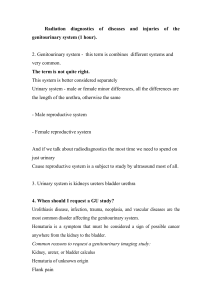
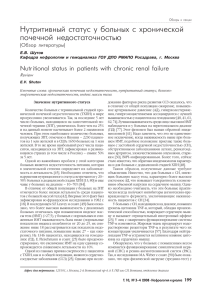
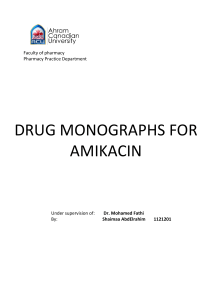
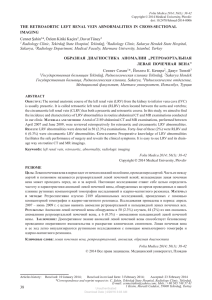
![ISSN 1561-6274. Нефрология. 2009. Том 13. №3. © Ì.Ì.Âîëêîâ, 2009 ÓÄÊ 616.61-036.12-008.9]:546.41+546.18](http://s1.studylib.ru/store/data/002088276_1-4bc2ed86dc4c87a6d852f5029de422b0-300x300.png)


